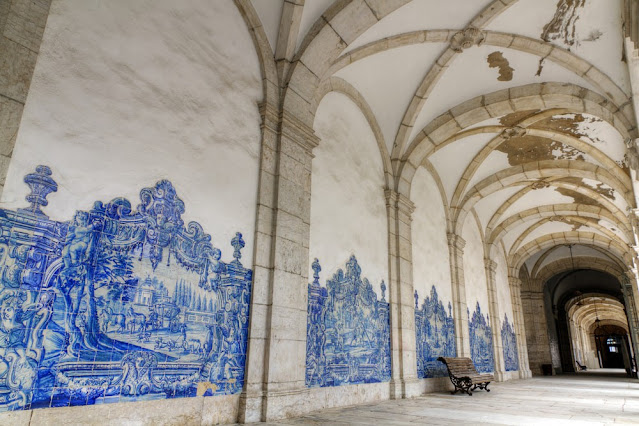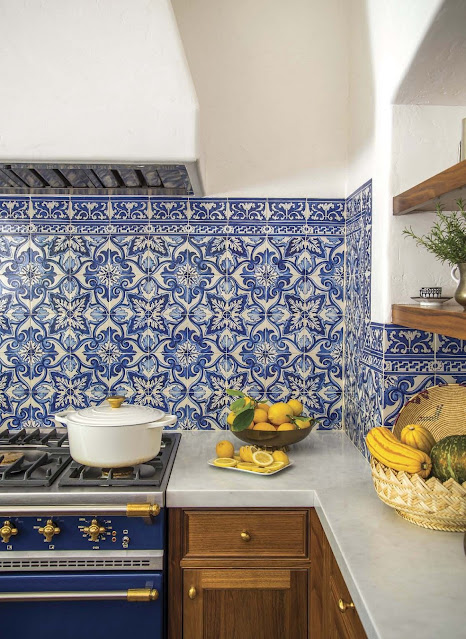Fabulous colorful azulejo tiles cover the facades and buildings of Portugal's capital Lisbon as well as other cities in the country. Everywhere you look there's a remarkable blue and white visual experience.
Pronounced ah-zoo-le-hos, these wonderful blue and white patterned tiles have become synonymous with Portugal. While the early type of colorful tile (which actually has an Arabic heritage) is also beautiful, my favorite, and the subject of this blog, is the blue and white variety introduced to Portugal in the second half of the 17th century from the Netherlands. The blue and white tiles have become the most dominant trend, and this is quite apparent in their immense presence all over the country today.
If you have a passion for blue and white, Lisbon will be Heaven on Earth for you. I hope you will enjoy learning about these Portuguese tiles and viewing ways to decorate your own interiors with a Portuguese ajulejos theme.
Portuguese tiles (called azulejos) are everywhere in Portugal. Today it is common to see them decorating everything from walls of churches and monasteries, to palaces, ordinary houses, park seats, public murals, fountains, shops, and restaurants.
People often think that these blue and white tiles are the standard colors of Portuguese tiles because they are so prevalent. Actually this decorating style was just the fashion of a certain period in the second half of the 17th century. Europeans were fascinated with Chinese porcelain. In an attempt to copy it, the Dutch began making tiles in the same blue and white tones. Massive imports were ordered from the Netherlands to decorate the interiors and exteriors of wealthy Portuguese homes and buildings.
In Portugal the decorative tiles are a construction material as well as decoration. Tiles on the outside helped protect interiors against damp, kept homes cooler in summer, and even reduced noise coming in from the street.
With so many buildings here having tile covered façades, blue and white azulejos, as they are known in Portuguese, have become a Portuguese trademark.
via Pinterest
In the beginning azulejo tiles were placed in geometric repeating styles that looked more Arabic in nature. Slowly azulejos became more elaborate and scenes were created with figurative images and murals.
The 18th century is considered the “Golden Age of the Azulejo." Italians established workshops and brought with them a form of tin-glazing pottery that allowed them to represent Italian Renaissance themes.
That is why religious and historical themes emerged and the tiles began to depict allegorical scenes from the Bible on interior and exterior walls. Hunting scenes were also popular.
Lisbon's Palácio Fronteira built in 1640, developed from an existing hunting lodge belonging to Marquês of Fronteira. The current Marquês lives there still and the blue and white Portuguese tile clad palace and it's beautiful gardens are open to the public. This picture shows the canal, decorated in 1756 with blue-and-white tile panels.
twitter.com
One of its finest architectural attractions are the 59 panels made of more than 3,800 customized tiles that were installed along the walls of the building by two Portuguese master tile-makers in the early part of the 18th century.
Dining room at Palácio Fronteira surrounded by blue and white azulejo tiles.
via Pinterest
Who wouldn't love drinking from this fountain!!
One of the best places to see azulejo tiles is the Igreja do Carmo. It is also considered one of the most beautiful churches in Portugal. Can you see why?
Capela das Almas is a chapel in Porta and is a great example of the use of blue and white azulejo tiles during the 19th and 20th century.
The paintings portray the life of St. Catherine of Alexandria and St. Francis of Assisi as the chapel is devoted to them. Just incredible!
The church commissioned religious themes but secular orders were for more Baroque style hunting, war, and daily court life scenes.
Sao Bento Railway Station was opened to the public in 1916 and is one of the most beautiful train stations in the world. It is well known for it's walls decorated with 20,000 splendid azulejo ceramic tiles which describe the History of Portugal.
via Pinterest
Jorge Colaço is the artist and it took him 11 years to complete this masterpiece.
Azulejos fell out of favor in the early 20th century. They were deemed "lower class" and outdated.
Can you imagine??
via Pinterest
In the 1950's the new metro stations were decorated with these iconic tiles. This was well received and was instrumental in starting an azulejo revival.
In Lisbon there is blue and white tile eye candy on everything from church chapels to backyard benches.
And when I say on everything I MEAN everything!
via Pinterest
One of the sad things happening in Lisbon is the theft of these beautiful tiles. There are so many everywhere no one can protect them all so many end up in antique stores where someone has stolen them for quick cash. Even tourists pry tiles off façades for souvenirs.
Housed in a magnificent old convent from 1509 and one of Lisbon’s most beautiful sights is it's Tile Museum. The Portuguese tile heritage is under threat from those who want to redevelop the city and who demolish old tiled buildings and discard pieces that are hundreds of years old and made in factories that no-longer exist.
via Pinterest
It is difficult to imagine a place like Lisbon without Azulejo tiles so I hope this destruction and theft can be stopped.
pinterest.co.uk
I love how some of the area homes are decorated with the azulejo tiles.
via pinterest.pt
Now for some blue and white Portuguese tile clad INTERIORS!
via Pinterest
The life size figures represented in tiles are called "figuras de convite" or welcoming figures. Panels of blue and white azulejo tiles displaying figures of palace staff such as footmen or even noblemen and elegant ladies were placed in the entrances of palaces and aristocratic homes.
Tile covered steps in Palacio Ramalhete which is a boutique hotel housed in an 18th-century palace.
casa.sapo.pt
decoranddineblog.com
Occupying the former hunting palace of the last Portuguese kings, the Palace do Bussaco is now a 5-star Hotel located in the Buçaco National Forest. With it's Gothic architecture and magnificent Portuguese tiles it is quite extraordinary.
Palácio dos Condes de Anadia is definitely a majestic Palace. The house was started in 1644 but it took three generations of the Paes do Amaral family and almost a century to complete it's decoration. Beautiful azulejo blue and white tiles cover the dado area of this room.
Another room with breathtaking Portuguese tiles in Palácio dos Condes de Anadia. If you are planning to use some tiles in your own interiors, you will see from the images that shades of red really pop against the blue and white.
The decoration of the surrounding frames for these tile scenes became increasingly important. They remind you of tapestries don't they?
via Pinterest
Heart be still!! Portugal's Palácio de Rio Frio was built at the beginning of this century and is beautifully decorated with fabulous blue and white tiles. I think it is similar to a Bed & Breakfast.
via Pinterest
Another view of the tiles in the dining room of Palácio de Rio Frio.
And Palácio de Rio Frio's lovely azulejo tiled stairway. I think a stairway would be a good project for a modern home's touch of Portugal.
Palacio Belmonte was built in 1449 during Portugal’s Moorish period and has remained in the Belmonte family for over five centuries. Sadly the property fell into disrepair with it's final occupants forced to live in one of the towers. Frederic P. Coustols, the French architectural philanthropist, stepped in to restore the building in 1995.
Beautiful Portuguese tiles in the home of antiques dealer Sylvain Lévy-Alban.
Via Vanity Fair
Celebrated photographer Todd Eberle captures the beauty of a blue and white Portuguese tile scene.
I can see this as a Portuguese tile headboard....can't you?
Portuguese tiles are even stunning when paired with a verdure tapestry.
An interior with blue and white Portuguese azulejos and transferware.....it just doesn't get any better!!
These tiles as so versatile they look good in any room of the house. Here in this old world kitchen they take center stage!
One could dream in blue and white in this tile covered bedroom in the Hotel Palácio Belmonte, Lisbon Portugal.
Bathrooms just BEG to be decorated with blue and white azulejo tiles.
This image, and the one below, are of Anouska Hempel's fabulous blue and white Portuguese tiled bathroom.
Anouska Hempel via architecturaldigest.com
loveisspeed.blogspot.com
Interior Designer Juan Pablo Molyneux in the blue and white azulejo tile clad room of his magnificent home.
via Pinterest
via Pinterest
Even more modern homes can benefit from a bit of azulejo tile on the exterior.
facebook.com
Let's take a look at some new homes and how homeowners have incorporated Portuguese tiles into their interiors.
Modern manufacturers of ceramic tiles still use the design features of Azulejos. They are available if you want the real thing.
This homeowner has chosen to cover the dining room dado with Portuguese tiles. The blue and white chairs and transfer wear place settings complete a stunning look.
But there are other ways you can get the look without breaking the bank. I love this idea for the bedroom.....except on an antique bed! They have even given the spread an aged look.
Portuguese style tile can adorn today's kitchen as well. Give your kitchen a modern Spanish style with a backsplash panel like this.
Jacques Grange
via Pinterest
Or use them under a bar or around an island.
Like I said the bath is another great place to try some Portuguese blue and white tiles in your own home. This tub area is perfect!
If you want this historic look in your home, the bathroom is the perfect place to create some magic.
There are no limits to the imagination. Be creative with these tiles.
etsy.com
You can even use printable wall art to frame and display in tile-like fashion. I think there are even stickable tiles you can buy and frame.
Maybe a Portuguese tile foyer, bath, or kitchen floor is an idea you hadn't thought of.
All images from zazzle.com
There actually are quite a few Portuguese tile style accessories to choose from. These are just a few.
I love the pouf!
1. Pottery Barn - waste basket
2. Wayfair.com - pillow
These azulejo style stair risers are actually done with stencils.
Don't forget outdoors. These tiles can create beautiful entertainment areas.
This is one of those blog topics I have to FORCE myself to end. I hope you have enjoyed the pics and maybe have taken away an idea or two!
Click here to see the previous post
This blog post was published by Lisa Farmer
In the event that I have not credited the correct source of an image, please contact me at lisafarmerdesigns46@yahoo.com and I would be glad to correct it.










































































